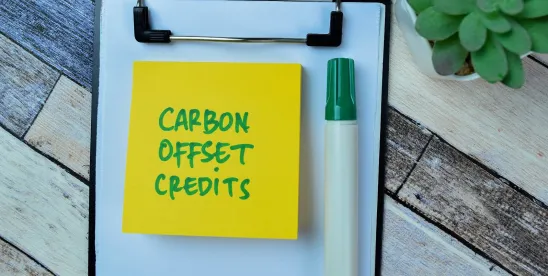Last week the Commodity Futures Trading Commission (CFTC) announced final guidance for voluntary carbon credit (“VCC”) derivatives contracts traded on CFTC-regulated designated contract markets (DCMs). This demonstrates further endorsement from the US government of the voluntary carbon market following the Joint Policy Statement and Principles (Principles) from the Biden administration in May this year.
While the Principles sought to bolster the supply and demand sides of the market, these CFTC guidelines are focused on bolstering the integrity and standardization of VCCs by outlining principles for their derivatives trading markets.
The nascent market for VCCs has grown at a substantial rate in recent years. Credits are sold to finance projects that reduce greenhouse gas (GHG) emissions and can be purchased by a company wanting to offset its carbon footprint. They are not established by any government body. Lack of fungibility and price transparency, imperfect means of validation and certification, risk of impermanence and green-washing concerns remain significant hurdles to widespread use of VCCs.
Background
The US government is clearly messaging with this guidance that it supports the development of the voluntary carbon market and that adherence to guidelines and standardization is key for its integrity and growth. CFTC Chairman Rostin Behnam announced that the guidance “is the product of a strong public-private partnership that I have strived to achieve with both the CFTC’s traditional stakeholders as well as a variety of voluntary carbon market stakeholders to support transparency, liquidity, and market integrity in the VCC derivatives markets as well as ultimately drive standardization and efficient capital allocation to scale the underlying cash market for high integrity VCCs.” Treasury Secretary Janet Yellen similarly believes the new CFTC guidelines will “promote the integrity of carbon credits and enable greater liquidity and price transparency” in the voluntary carbon markets.
Exchange-traded derivatives contracts such as the NYMEX Henry Hub gas futures contract are fungible, having standardized terms for the quality and quantity for the physical or financial product underlying the futures. The only variable for most commodity futures contract is price. Futures trading fosters liquidity and price transparency in the underlying physical and cash-settled markets by providing price discovery and a means of hedging financial risk for those markets. VCCs, in contrast to Henry Hub gas, currently are not fungible products. Although every VCC represents, upon retirement, the elimination of one ton of GHG emissions by a project, each VCC’s value will be affected by the nature and risks of its particular project, and the array of project types and jurisdictions is wide and varied (including, among others, carbon capture, biogas and forest management). While the CFTC guidance does not create standardization across different VCCs, it may promote some degree of price transparency in the VCC market by providing a set of common standards for qualifying VCCs to underlie exchange-traded derivatives.
As with the Principles, the CFTC emphasizes that these are not binding rules. The US government rather hopes to drive forward the voluntary carbon market through with this framework for DCMs while preserving the unregulated basis of the market.
Guidelines
The CFTC guidelines specify various factors to be considered by a DCM when listing VCC contracts. This guidance provides a valuable road map to the market for assessing a VCC transaction and comparing VCC products. VCCs should always be verified by a reputable organization, generally known as a “carbon registry.” The largest such registries are American Carbon Registry, Climate Action Reserve, Gold Standard and Verra. Each registry has standards for different types of VCC products. These standards set forth criteria by which underlying carbon reduction projects are structured, verified and validated, and not all standards or projects are created equal. As the new guidance makes clear, market practices, policies and procedures continue to evolve, and the CFTC makes no attempt to provide a standardized framework to evaluate and compare VCCs.
The CFTC’s guidance advises that the following factors should be considered by a DCM listing a VCC contract, and it would appear that any potential purchaser in a VCC transaction is wise to consider them as well:
- Quality Standards:
- Transparency: Information relating to the VCC crediting program and project should be publicly available in a searchable and comparable format to assist market participants to make informed evaluations and comparisons of the quality of the underlying VCCs.
- “Additionality”: The VCC crediting program should include consistent and reliable procedures to assess that the project creates emissions reductions that would in fact not otherwise occur. Importantly, the CFTC made no attempt to define additionality (leaving it to future industry-consensus on how best to characterize and assess additionality).
- Permanence and Risk of Reversal: The VCC crediting program should include measures to address and account for the risk of reversal, such as a common buffer reserve or “pool” (e.g., the risk that VCCs financing forestation will become valueless if the forest later burns down).
- Robust Quantification: The program for assessing the quantity of VCCs that a project will legitimately support should be “robust, conservative, and transparent”.
- Delivery Points and Facilities: The VCC crediting program should include a governance framework and tracking mechanisms to prevent double counting (e.g., preventing multiple different VCCs on different registries from being backed by the same trees or relevant ton of emission removed and ensuring retirement/offsetting of a VCC is done only once).
- Inspection Procedures: The VCC crediting program should address inspection and certification procedures for verifying compliance with the quality and delivery requirements that reflect the latest practices in the voluntary carbon markets, as well as best practices with respect to third party validation and verification.
- Duty to Update: The DCM must monitor the terms and conditions to ensure the VCC contracts reflect the latest applicable certification standard(s), and the contract terms and conditions should be amended as necessary to reflect any updates.
These are standards with which the market is familiar as there is some clear overlap with the standards set out by existing quasi-regulatory bodies, which we have explored in detail in a prior article.
The CFTC’s intent to advance carbon markets and emission reduction through is guidance is clear. “The CFTC’s unique mission focused on risk mitigation and price discovery puts us on the front lines of the now global nexus between financial markets and decarbonization efforts. Leveraging the CFTC’s personnel and expertise demonstrates our commitment to taking a thoughtful and deliberate step toward building a financial system that provides effective tools in achieving emission reductions,” said Chairman Behnam.
Significant to some commentators, the CFTC guidelines also include quality standards relating to ESG safeguards and net zero alignment that “avoid locking in levels of GHG emissions, technologies or carbon intensive practices that are incompatible with the objective of achieving net zero GHG emissions by 2050.” Some have objected to the guidelines as the CFTC’s attempt to indirectly regulate the voluntary carbon credits markets, including Republican Commissioner Summer Mersinger in her dissent from the Commission’s adoption of the guidance. “Focusing on ESG and Net Zero in evaluating derivatives contracts is a backdoor attempt to inject and memorialize certain political ideologies into CFTC regulatory decisions,” noted Commissioner Mersinger. Such dissenting voices highlight the juggling act the US government faces in pushing to encourage the integrity of the voluntary carbon market without cementing inflexible regulation.
Conclusion
To date, 29 VCC futures contracts have been listed for trading on NYMEX and the Nodal Exchange, but only three VCC futures, all listed on NYMEX, currently have open interest.
The new CFTC guidelines represent one of several steps taken by the US government to encourage the scaling of VCC trading and to champion the voluntary carbon market in its entirety.






 />i
/>i

